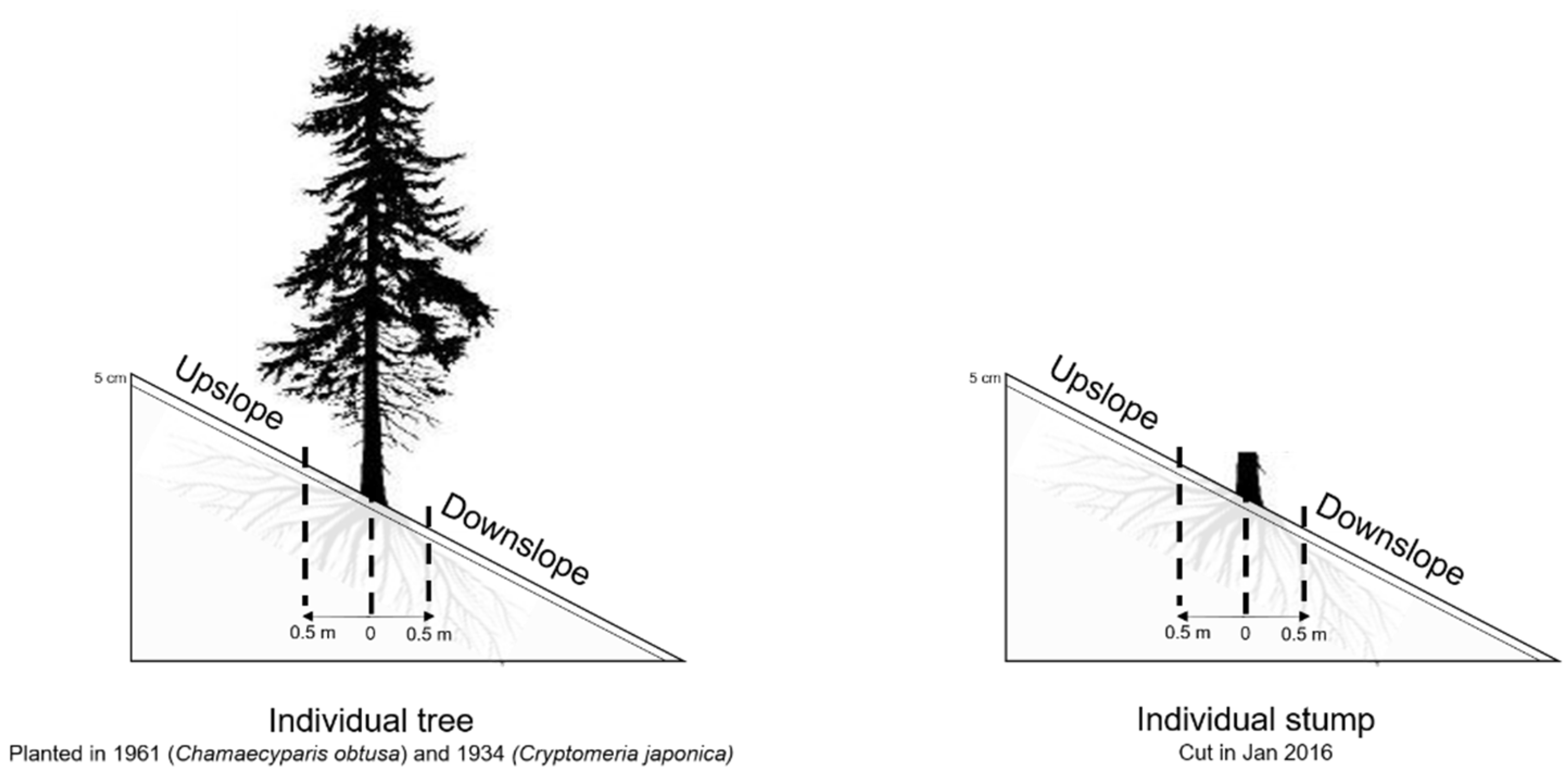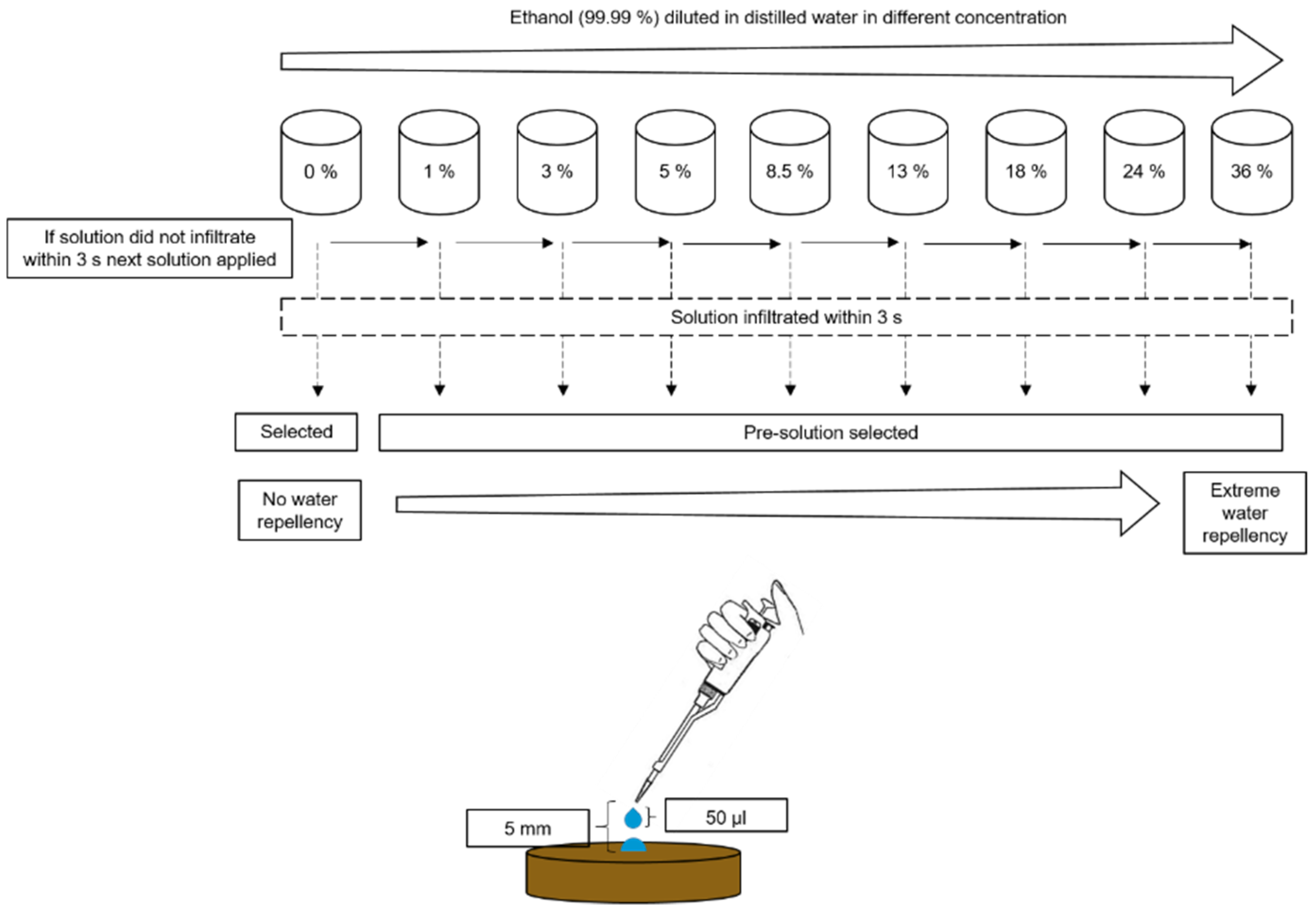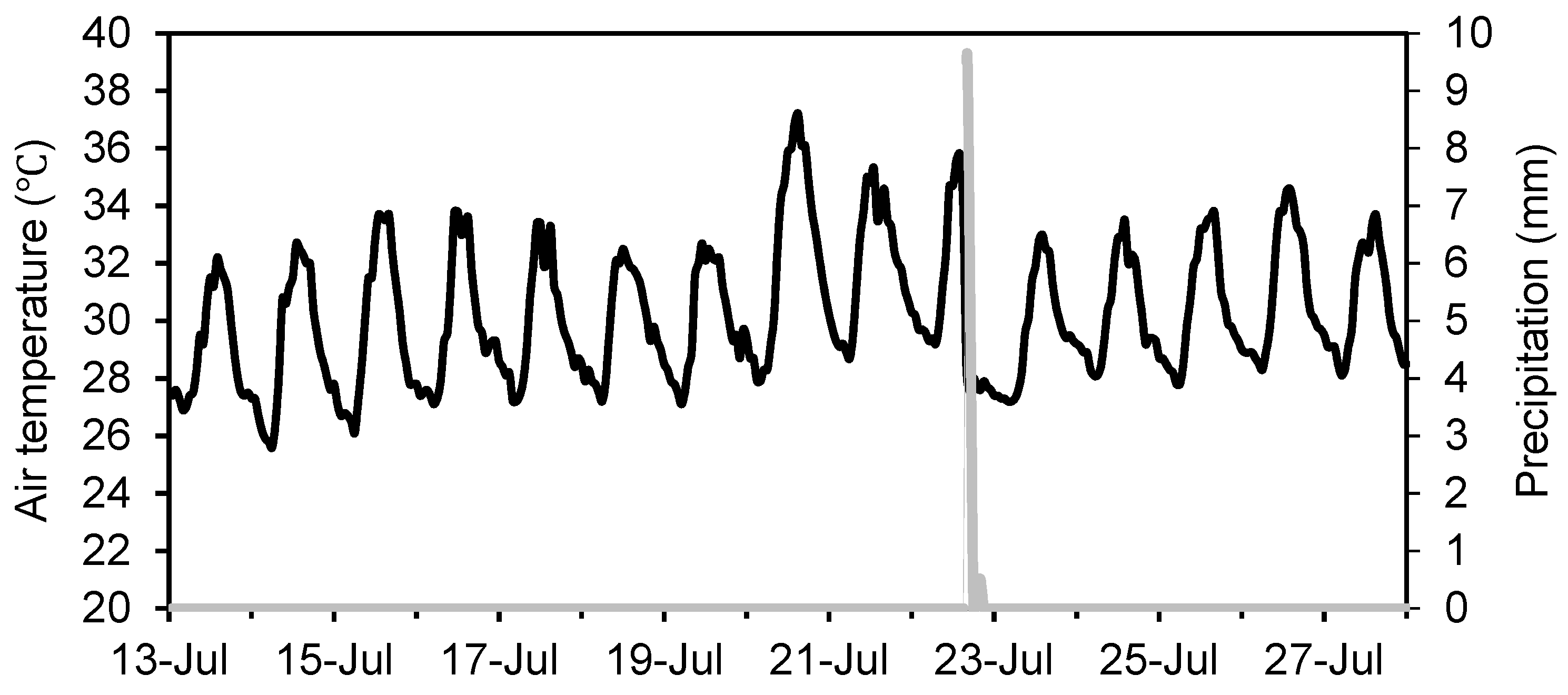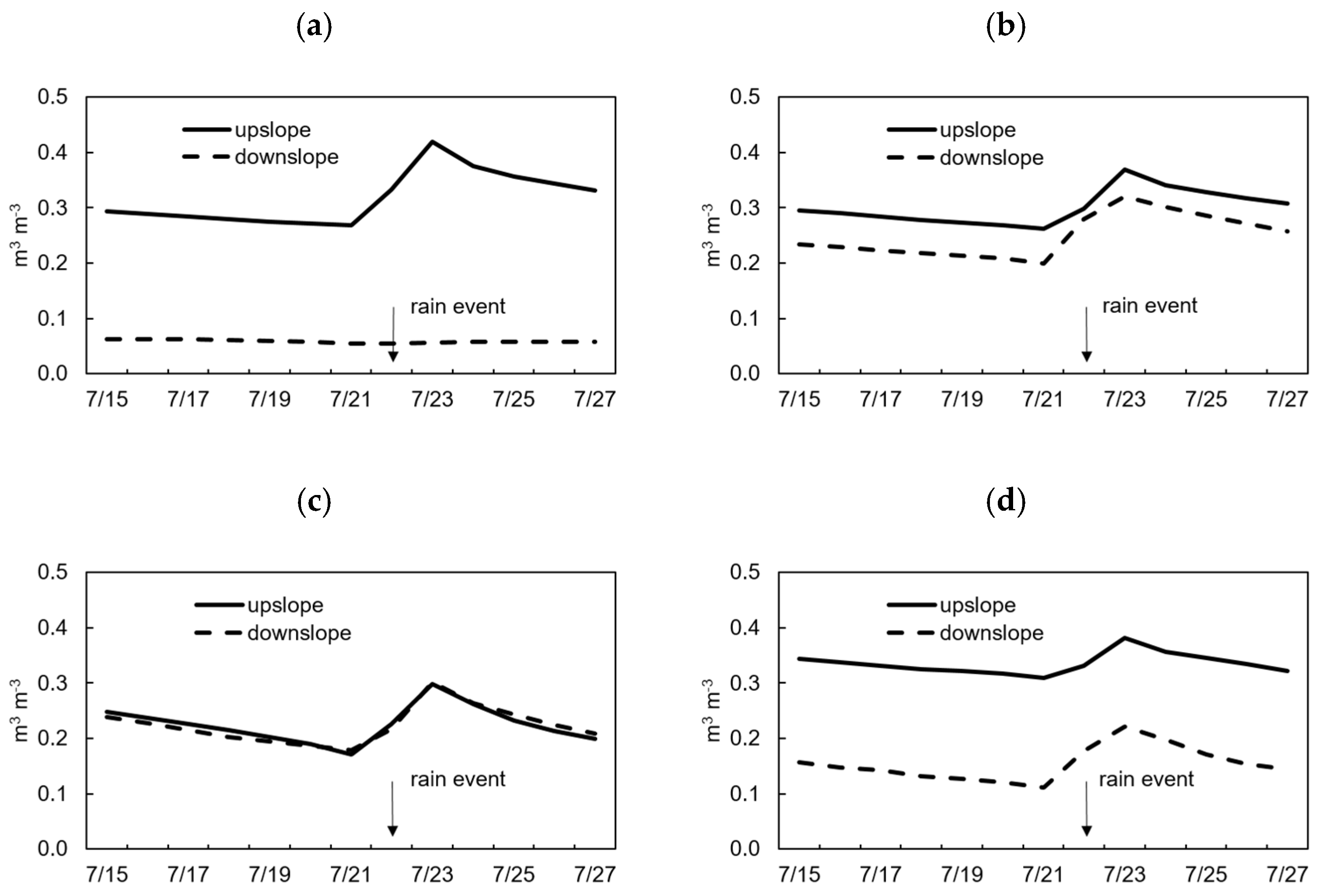Factors Determining Soil Water Repellency in Two Coniferous Plantations on a Hillslope
Abstract
:1. Introduction
2. Materials and Methods
2.1. Study Site and Sampling Design
2.2. Sample Preparation for SWR Tests
2.3. Molarity of an Ethanol Droplet Test
2.4. Soil Water and Moisture Content Measurement
2.5. Soil Aggregate Stability
2.6. Statistical Analysis
3. Results
4. Discussion
5. Conclusions
Author Contributions
Funding
Acknowledgments
Conflicts of Interest
References
- Hallett, P.D. A brief overview of the causes, impacts and amelioration of soil water repellency—A review. Soil Water Res. 2008, 3, S21–S28. [Google Scholar] [CrossRef]
- Farahnak, M.; Mitsuyasu, K.; Jeong, S.; Otsuki, K.; Chiwa, M.; Sadeghi, S.M.M.; Kume, A. Soil hydraulic conductivity differences between upslope and downslope of two coniferous trees on a hillslope. J. For. Res 2019, 24, 143–152. [Google Scholar] [CrossRef]
- Gomi, T.; Sidle, R.C.; Miyata, S.; Kosugi, K.; Onda, Y. Dynamic runoff connectivity of overland flow on steep forested hillslopes: Scale effects and runoff transfer. Water Resour. Res. 2008, 44, 1–16. [Google Scholar] [CrossRef]
- Gomi, T.; Sidle, R.C.; Ueno, M.; Miyata, S.; Kosugi, K. Characteristics of overland flow generation on steep forested hillslopes of central Japan. J. Hydrol. 2008, 361, 275–290. [Google Scholar] [CrossRef]
- Miyata, S.; Kosugi, K.I.; Gomi, T.; Onda, Y.; Mizuyama, T. Surface runoff as affected by soil water repellency in a Japanese cypress forest. Hydrol. Process. 2007, 21, 2365–2376. [Google Scholar] [CrossRef]
- Mataix-Solera, J.; Arcenegui, V.; Guerrero, C.; Mayoral, A.M.; Morales, J.; González, J.; García-Orenes, F.; Gómez, I. Water repellency under different plant species in a calcareous forest soil in a semiarid Mediterranean environment. Hydrol. Process. 2007, 21, 2300–2309. [Google Scholar] [CrossRef]
- Jiménez-Morillo, N.T.; Spangenberg, J.E.; Miller, A.Z.; Jordán, A.; Zavala, L.M.; González-Vila, F.J.; González-Pérez, J.A. Wildfire effects on lipid composition and hydrophobicity of bulk soil and soil size fractions under Quercus suber cover (SW-Spain). Environ. Res. 2017, 159, 394–405. [Google Scholar] [CrossRef] [PubMed]
- Benito, E.; Varela, E.; Rodríguez-Alleres, M. Persistence of water repellency in coarse-textured soils under various types of forests in NW Spain. J. Hydrol. Hydromech. 2019, 67, 129–134. [Google Scholar] [CrossRef] [Green Version]
- Doerr, S.; Shakesby, R.; Walsh, R.; Doerr, S. Soil water repellency: its causes, characteristics and hydro-geomorphological significance. Earth-Sci. Rev. 2000, 51, 33–65. [Google Scholar] [CrossRef]
- Wijewardana, N.S.; Mueller, K.; Moldrup, P.; Clothier, B.; Komatsu, T.; Hiradate, S.; De Jonge, L.W.; Kawamoto, K. Soil-water repellency characteristic curves for soil profiles with organic carbon gradients. Geoderma 2016, 264, 150–159. [Google Scholar] [CrossRef]
- De Jonge, L.W.; Jacobsen, O.H.; Moldrup, P. Soil Water Repellency: Effects of Water Content, Temperature, and Particle Size. Soil Sci. Soc. Am. J. 1999, 63, 437–442. [Google Scholar] [CrossRef]
- Kobayashi, M.; Shimizu, T. Soil water repellency in a Japanese cypress plantation restricts increases in soil water storage during rainfall events. Hydrol. Process. 2007, 21, 2356–2364. [Google Scholar] [CrossRef]
- Blackwell, P. Improving sustainable production from water repellent sands. J. Dep. Agric. West. Aust. 1993, 34, 160–167. [Google Scholar]
- Franco, C.M.M.; Clarke, P.J.; Tate, M.E.; Oades, J.M. Hydrophobic properties and chemical characterization of natural water repellent materials in Australian Sands. J. Hydrol. 2000, 231, 47–58. [Google Scholar] [CrossRef]
- Dekker, L.W.; Oostindie, K.; Ritsema, C.J. Exponential increase of publications related to soil water repellency. Soil Res. 2005, 43, 403. [Google Scholar] [CrossRef]
- Doerr, S.H.; Shakesby, R.A.; Dekker, L.W.; Ritsema, C.J.; Doerr, S. Occurrence, prediction and hydrological effects of water repellency amongst major soil and land-use types in a humid temperate climate. Eur. J. Soil Sci. 2006, 57, 741–754. [Google Scholar] [CrossRef]
- Kobayashi, M.; Tsurita, T.; Itoh, Y.; Kato, M. Spatial Distribution of Soil Water Repellency in a Japanese Cypress Plantation and an Adjacent Deciduous Broad-leaved Forest. J. Jpn. For. Soc. 2006, 88, 354–362. [Google Scholar] [CrossRef]
- Badía-Villas, D.; González-Pérez, J.A.; Aznar, J.M.; Arjona-Gracia, B.; Martí-Dalmau, C. Changes in water repellency, aggregation and organic matter of a mollic horizon burned in laboratory: Soil depth affected by fire. Geoderma 2014, 213, 400–407. [Google Scholar] [CrossRef]
- Lozano, E.; García-Orenes, F.; Bárcenas-Moreno, G.; Jiménez-Pinilla, P.; Mataix-Solera, J.; Arcenegui, V.; Morugán-Coronado, A.; Mataix-Beneyto, J. Relationships between soil water repellency and microbial community composition under different plant species in a Mediterranean semiarid forest. J. Hydrol. Hydromech. 2014, 62, 101–107. [Google Scholar] [CrossRef] [Green Version]
- Olorunfemi, I.E.; Fasinmirin, J.T. Land use management effects on soil hydrophobicity and hydraulic properties in Ekiti State, forest vegetative zone of Nigeria. Catena 2017, 155, 170–182. [Google Scholar] [CrossRef]
- Liang, W.-L.; Kosugi, K.; Mizuyama, T. Characteristics of stemflow for tall stewartia (Stewartia monadelpha) growing on a hillslope. J. Hydrol. 2009, 378, 168–178. [Google Scholar] [CrossRef] [Green Version]
- Liang, W.L.; Kosugi, K.I.; Mizuyama, T. Soil water redistribution processes around a tree on a hillslope: the effect of stemflow on the drying process. Ecohydrology 2015, 8, 1381–1395. [Google Scholar] [CrossRef]
- Peng, S.L.; Wu, J.; You, W.H. Recovery of saturated hydraulic conductivity along a forest successional series from abandoned land to mature, evergreen broad-leaved forest in eastern China. Soil Res. 2012, 50, 257. [Google Scholar] [CrossRef]
- Dung, B.X.; Gomi, T.; Miyata, S.; Sidle, R.C.; Kosugi, K.; Onda, Y. Runoff responses to forest thinning at plot and catchment scales in a headwater catchment draining Japanese cypress forest. J. Hydrol. 2012, 444, 51–62. [Google Scholar] [CrossRef]
- Fukushima, K.; Tateno, R.; Tokuchi, N. Soil nitrogen dynamics during stand development after clear-cutting of Japanese cedar (Cryptomeria japonica) plantations. J. For. Res. 2011, 16, 394–404. [Google Scholar] [CrossRef] [Green Version]
- Kreutzweiser, D.P.; Hazlett, P.W.; Gunn, J.M. Logging impacts on the biogeochemistry of boreal forest soils and nutrient export to aquatic systems: A review. Environ. Rev. 2008, 16, 157–179. [Google Scholar] [CrossRef]
- Takahashi, M. Effect of slash on soil solution chemistry after clearcutting of a Japanese cedar (Cryptomeria japonica) plantation. J. Jpn. For. Soc. 1995, 77, 124–130. [Google Scholar]
- Japan Forestry Agency. 2017: Annual Report on Forest and Forestry in Japan Fiscal Year 2016. Available online: http://www.rinya.maff.go.jp/j/kikaku/hakusyo/28hakusyo/attach/pdf/index-1.pdf (accessed on 25 May 2019).
- Kobayashi, M. Quantification of soil water repellency using aqueous ethanol solution method. Kyushu J. For. Res. 2003, 56, 251–252. (In Japanese) [Google Scholar]
- Jiménez-Morillo, N.T.; González-Pérez, J.A.; Jordán, A.; Zavala, L.M.; de la Rosa, J.M.; Jiménez-González, M.A.; González-Vila, F.J. Organic matter fractions controlling soil water repellency in sandy soils from the Doñana National Park (Southwestern Spain). Land Degrad. Dev. 2016, 27, 1413–1423. [Google Scholar] [CrossRef]
- Doerr, S.H. On standardizing the ‘Water Drop Penetration Time’ and the ‘Molarity of an Ethanol Droplet’ techniques to classify soil hydrophobicity: A case study using medium textured soils. Earth Surf. Process. Landf. 1998, 23, 663–668. [Google Scholar] [CrossRef]
- Japanese Industrial Standard Association. JIS A 1203 Test Method for Water Content of Soils. 2009. Available online: https://infostore.saiglobal.com/en-au/Standards/JIS-A-1203-2009-632170_SAIG_JSA_JSA_1456210/ (accessed on 28 May 2019).
- Van Bavel, C.H.M. Mean Weight-Diameter of Soil Aggregates as a Statistical Index of Aggregation1. Soil Sci. Soc. Am. J. 1950, 14, 20. [Google Scholar] [CrossRef]
- DeBano, L.F. Water Repellent Soils: A State-of-the-Art; General Technical Report PSW-46; Pacific Southwest Forest and Range Experiment Station, Forest Service, U.S. Department of Agriculture: Berkeley, CA, USA, 1981; p. 21. [Google Scholar]
- Van Dam, J.; Hendrickx, J.; Van Ommen, H.; Bannink, M.; Van Genuchten, M.; Dekker, L. Water and solute movement in a coarse-textured water-repellent field soil. J. Hydrol. 1990, 120, 359–379. [Google Scholar] [CrossRef]
- Leelamanie, D.A.L.; Nishiwaki, J. Water repellency in Japanese coniferous forest soils as affected by drying temperature and moisture. Biologia 2019, 74, 127–137. [Google Scholar] [CrossRef]
- Clothier, B.; Vogeler, I.; Magesan, G.; Clothier, B. The breakdown of water repellency and solute transport through a hydrophobic soil. J. Hydrol. 2000, 231, 255–264. [Google Scholar] [CrossRef]
- Lützow, M.V.; Kögel-Knabner, I.; Ekschmitt, K.; Matzner, E.; Guggenberger, G.; Marschner, B.; Flessa, H. Stabilization of organic matter in temperate soils: mechanisms and their relevance under different soil conditions—A review. Eur. J. Soil Sci. 2006, 57, 426–445. [Google Scholar] [CrossRef]
- Wallis, M.G.; Horne, D.J. Soil water repellency. In Advances in Soil Science; Springer: New York, NY, USA, 1992; pp. 91–146. [Google Scholar]








| Tree Species | Plot | Sand | Silt | Clay | Soil Texture | Soil Bulk Density | Soil Porosity |
|---|---|---|---|---|---|---|---|
| (%) | (g cm−3) | (%) | |||||
| Chamaecyparis obtusa | Intact tree | 75.14 | 15.59 | 09.28 | Loam | 0.87 ± 0.02 | 65.59 ± 0.91 |
| Cut tree | 73.08 | 15.14 | 11.78 | Loamy sand | 0.87 ± 0.04 | 65.60 ± 1.73 | |
| Cryptomeria japonica | Intact tree | 63.13 | 25.92 | 10.94 | Loamy sand | 1.02 ± 0.03 | 59.88 ± 1.35 |
| Cut tree | 70.03 | 20.24 | 09.72 | Silty loam | 0.97 ± 0.03 | 62.18 ± 1.24 |
| Tree Species | Type | Position | SOM (%) | θg (g g−1) | MWD (mm) |
|---|---|---|---|---|---|
| Ch. obtusa | Individual trees | U * | 13.62 ± 1.12 | 0.06 ± 0.00 | 5.39 ± 0.06 |
| D ** | 14.18 ± 1.59 | 0.06 ± 0.00 | 5.47 ± 0.03 | ||
| m *** | 13.90 ± 0.92 | 0.06 ± 0.00 | 5.43 ± 0.03 | ||
| Individual stumps | U | 19.03 ± 3.97 | 0.05 ± 0.00 | 5.28 ± 0.09 | |
| D | 11.81 ± 1.16 | 0.05 ± 0.00 | 5.39 ± 0.05 | ||
| m | 15.42 ± 2.29 | 0.05 ± 0.00 | 5.33 ± 0.05 | ||
| Cr. japonica | Individual trees | U | 14.96 ± 1.91 | 0.07 ± 0.01 | 4.93 ± 0.l1 |
| D | 12.23 ± 1.03 | 0.04 ± 0.00 | 5.37 ± 0.02 | ||
| m | 13.60 ± 1.12 | 0.06 ± 0.01 | 5.15 ± 0.09 | ||
| Individual stumps | U | 11.29 ± 1.25 | 0.08 ± 0.02 | 5.00 ± 0.03 | |
| D | 10.06 ± 0.58 | 0.06 ± 0.00 | 5.04 ± 0.09 | ||
| m | 10.67 ± 0.68 | 0.07 ± 0.01 | 5.02 ± 0.05 |
| Tree Species | Type | Position | SOM | θg | MWD |
|---|---|---|---|---|---|
| Ch. obtusa | Individual trees | U | −0.26 | 0.85 | 0.93 * |
| D | −0.51 | 0.14 | 0.59 | ||
| m | −0.23 | 0.52 | 0.88 * | ||
| Individual stumps | U | 0.68 | 0.26 | 0.40 | |
| D | 0.30 | 0.53 | 0.01 | ||
| m | 0.58 | 0.30 | 0.29 | ||
| Cr. japonica | Individual trees | U | −0.14 | 0.52 | 0.94 * |
| D | −0.63 | −0.23 | 0.05 | ||
| m | −0.11 | 0.47 | 0.25 | ||
| Individual stumps | U | −0.65 | 0.42 | −0.51 | |
| D | 0.25 | 0.38 | 0.23 | ||
| M | −0.33 | 0.36 | −0.00 |
© 2019 by the authors. Licensee MDPI, Basel, Switzerland. This article is an open access article distributed under the terms and conditions of the Creative Commons Attribution (CC BY) license (http://creativecommons.org/licenses/by/4.0/).
Share and Cite
Farahnak, M.; Mitsuyasu, K.; Otsuki, K.; Shimizu, K.; Kume, A. Factors Determining Soil Water Repellency in Two Coniferous Plantations on a Hillslope. Forests 2019, 10, 730. https://doi.org/10.3390/f10090730
Farahnak M, Mitsuyasu K, Otsuki K, Shimizu K, Kume A. Factors Determining Soil Water Repellency in Two Coniferous Plantations on a Hillslope. Forests. 2019; 10(9):730. https://doi.org/10.3390/f10090730
Chicago/Turabian StyleFarahnak, Moein, Keiji Mitsuyasu, Kyoichi Otsuki, Kuniyoshi Shimizu, and Atsushi Kume. 2019. "Factors Determining Soil Water Repellency in Two Coniferous Plantations on a Hillslope" Forests 10, no. 9: 730. https://doi.org/10.3390/f10090730








